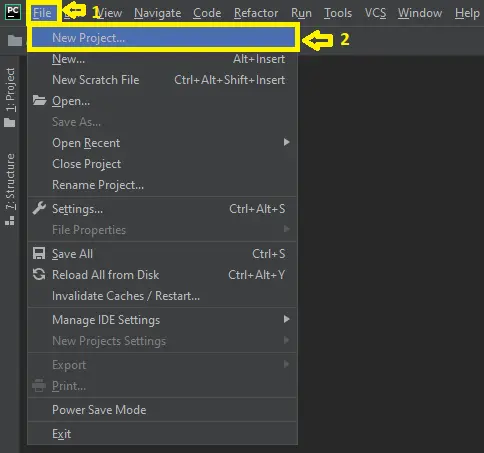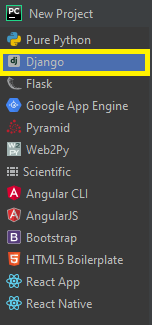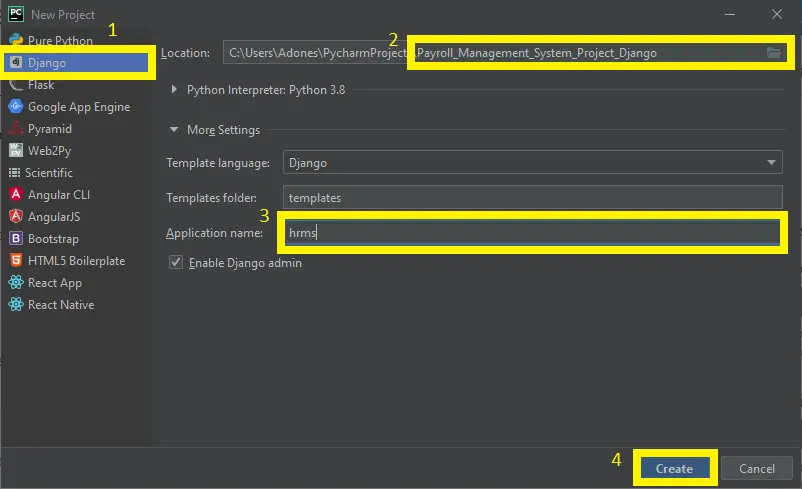A Payroll Management System in Django, Keeps track of all of the employee’s information and data. We’ve created all of the employee’s, company, voucher, payrolls, logs, and general settings crud (create, read, update, and delete) operations.
This is a role-based module in which the admin can perform any operation on the data.
The payroll module is typically used to handle employees salary while the company module handles company features.
The Payroll Management System is an easy project for beginners to learn how to build a web-based python Django project.
We will provide you with the complete source code and database for the python project so that you can easily install it on your machine and learn how to program in Python Django.
To start creating a Payroll Management System Project in Python Django, makes sure that you have PyCharm Professional IDE Installed in your computer.
This Payroll Management System in Django Framework, Also includes a Download Source Code for free, just find the downloadable source code below and click download now.
| About Project | Project Details |
|---|---|
| Project Name | Payroll Management System Project in Django |
| Python version (Recommended) | 3.8 Version |
| Programming Language Used | Python Django Language |
| Developer Name | itsourcecode.com |
| IDE Tool (Recommended) | Sublime, Visual Studio, PyCharm |
| Project Type | Web Application |
| Database | SQLite |
Admin Features of Payroll Management System Project in Django
- Manage Employee – For the employee, The admin can add, and edit, employee information.
- Company Management – For the company, The admin can see the list of company details. Admin can update the record of the company details.
- Manage payroll– For the payroll, The admin can view the list of payroll details. Admin can create a payroll to their employees.
- Manage Voucher– For the voucher, The admin can add, and edit, voucher information.
- Login – By default the admin need to login first to enable to access the system.
- Manage logs– For the logs, The admin can view all the logs.
- Manage Company– For the Company, The admin can add, edit, and delete company information.
Payroll Management System Project in Django Steps on How to Create a Project
Time needed: 5 minutes
Here are the steps on how to create a Payroll Management System Project in Django
- Step 1: Open file.
First , open “pycharm professional” after that click “file” and click “new project”.

- Step 2: Choose Django.
Next, after click “new project“, choose “Django” and click.

- Step 3: Select file location.
Then, select a file location wherever you want.

- Step 4: Create application name.
After that, name your application.

- Step 5: Click create.
Lastly, finish creating project by clicking “create” button.

- Step 6: Start Coding.
Finally, we will now start adding functionality to our Django Framework by adding some functional codes.
Functionality and Codes of the Payroll Management System Project in Django
- Create template for the login in form in Payroll Management System Project in Django.
In this section, we will learn on how create a templates for the login form. To start with, add the following code in your login.html under the folder of login/templates/login.
<html>
<header>
{% load static %}
<title>Login</title>
<link rel="stylesheet" type="text/css" href="{% static 'dashboard/css/bootstrap.min.css' %}">
<link href="https://fonts.googleapis.com/css?family=Raleway|Roboto+Condensed" rel="stylesheet">
<link rel="stylesheet" type="text/css" href="{% static 'myaccount/style.css' %}">
<script href="https://maxcdn.bootstrapcdn.com/bootstrap/3.3.7/js/bootstrap.min.js"></script>
<script
src="https://code.jquery.com/jquery-3.2.1.min.js"
integrity="sha256-hwg4gsxgFZhOsEEamdOYGBf13FyQuiTwlAQgxVSNgt4="
crossorigin="anonymous"></script>
</header>
<body>
<div class="container">
<div class="row">
<div class="col-sm-6 col-sm-push-3 login-div">
{% if message %}
<div class="alert alert-danger alert-dismissable "><a href="#" class="close" data-dismiss="alert" aria-label="close">×</a>{{ message }}</div>
{% endif %}
<div class='card'>
<form method="post" class="">
{% csrf_token %}
{% for field in form %}
<div class="form-group">
{{field.label_tag}}
{{ field }}
</div>
{% endfor %}
<button type="submit" name="submit" class="btn btn-primary form-control"/>Login</button>
</form>
</div>
</div>
</div>
</div>
</body>
</html>
- Create template for the employee table in Payroll Management System Project in Django.
In this section, we will learn on how create a templates for the employee table. To start with, add the following code in your all_employees.html under the folder of employee/templates/employee.
{% extends "hrms/base.html" %}
{% load crispy_forms_tags %}
{% block content %}
<div class="card">
<div class="card-header">
<h4 class="card-title">
{{ head }}
</h4>
</div>
<div class="card-body">
<a href='{% url "employee-add" %}' class="btn btn-danger" >Add Employee</a>
{% comment %} <form class="form-control" action="{% url 'search-employees' %}" method="post" style="margin-top: 10px">
{% csrf_token %}
<div class="row">
<div class="col example-grid-col">
<select class="form-control" name="company">
<option value="">Choose company</option>
{% for com in companies %}
<option value="{{com.company_name}}">{{com.company_name}}</option>
{% endfor %}
</select>
</div>
<div class="col example-grid-col">
<input type="text" class="form-control" name="employee_name" value="" placeholder="Search by employee">
</div>
<div class="col example-grid-col">
<select class="form-control" name="payment_method">
<option value="">Choose payment method</option>
<option value="daily">daily</option>
<option value="weekly">weekly</option>
<option value="semi-monthly">semi-monthly</option>
<option value="monthly">monthly</option>
</select>
</div>
<div class="col example-grid-col">
<input type="text" name="start_date" value="" class="datepicker dateinput form-control" id="id_date_hired" placeholder="Start Date">
</div>
<div class="col example-grid-col">
<input type="text" name="end_date" value="" class="datepicker dateinput form-control" id="id_date_hired" placeholder="End Date">
</div>
<div class="col example-grid-col">
<select class="form-control" name="search_by">
<option value="">Choose Search By</option>
<option value="date_hired">Date Hired</option>
<option value="contract_expiration">Contract Expiration</option>
</select>
</div>
<div class="col example-grid-col">
<select class="form-control" name="order">
<option value="">Choose Order</option>
<option value="ascending">ascending</option>
<option value="descending">descending</option>
</select>
</div>
<div class="col example-grid-col">
<button type="submit" class="btn btn-info" name="button">Search</button>
</div>
</div>
</form> {% endcomment %}
<link rel="stylesheet" href="https://cdnjs.cloudflare.com/ajax/libs/twitter-bootstrap/4.1.3/css/bootstrap.css">
<link rel="stylesheet" href="https://cdn.datatables.net/1.10.19/css/dataTables.bootstrap4.min.css">
<div class="table-responsive" style="margin-top: 10px">
<table id="example" class="table table-striped table-bordered" style="width:100%">
<thead class="bg-success text-white">
<tr>
<th scope="col" class="text-center">#</th>
<th scope="col" class="text-center">Emp Id</th>
<th scope="col" class="text-center">Employee Name</th>
<th scope="col" class="text-center">SSS</th>
<th scope="col" class="text-center">Phone</th>
<th scope="col" class="text-center">Position</th>
<th scope="col" class="text-center">Company</th>
<th scope="col" class="text-center">Date Hired</th>
<th scope="col" class="text-center">Contact Expiration</th>
<th scope="col" class="text-center">Remarks</th>
<th scope="col" class="text-center">Action</th>
</tr>
</thead>
<tbody>
{% for emp in employees %}
<tr>
<th class="align-middle text-center" scope="row">{{ forloop.counter}}</th>
<td class="align-middle text-center">{{ emp.emp_id }} </td>
<td class="align-middle text-center">{{ emp }} </td>
<td class="align-middle text-center">{{ emp.get_hiring_details.sss }}</td>
<td class="align-middle text-center">{{ emp.phone }}</td>
<td class="align-middle text-center">{{ emp.get_hiring_details.position }}</td>
<td class="align-middle text-center">{{ emp.company }}</td>
<td class="align-middle text-center">{{ emp.date_hired }}</td>
<td class="align-middle text-center">{{ emp.contract_expiration }}</td>
<td class="align-middle text-center">{{ emp.remarks }}</td>
<td class="align-middle text-center">
<a href="{% url 'employee-update' emp.id %}" class="btn btn-danger">Update</a>
</td>
</tr>
{% endfor %}
</tbody>
</table>
</div>
</div>
</div>
{% endblock content %}
- Create template for the base in Payroll Management System Project in Django.
In this section, we will learn on how create a templates for the base. To start with, add the following code in your base.html under the folder of hrms/templates/hrms.
Downloadable Source Code Below.
Anyway, if you want to level up your programming knowledge, especially python, try this new article I’ve made for you Best Python Projects with source code for Beginners.
But If you’re going to focus on web development using Django, you can download here from our list of Best Django Projects with source code based on real-world projects.
How To Run The Payroll Management System Project in Django?
- Step 1: Extract/unzip the file
- Step 2: Go inside the project folder, open cmd and type the following commands to install Django Framework and run the webserver:
- pip install -r requirements.txt
- python manage.py migrate
- python manage.py runserver
- Step 3: Finally, open the browser and go to http://127.0.0.1:8000/
For admin panel:
- Username: admin
- Password: adminl12345
Summary
In summary, this Payroll Management System Project in Django with Source Code can be useful to students or professional who wants to learn python programming language.
This project can also be modified to fit your personal requirements. Hope this project will help you to improve your skills. Happy Coding!
Checkout the linked below about the related articles.
- Human Resource Management System Project in Django
- Django Employee Management System with Source Code
- Payroll Management System Project In Python With Source Code
- Django Leave Management System With Source Code
Inquiries
If you have any questions or suggestions about Payroll Management System Project in Django with Source Code, please feel free to leave a comment below.







installed but login failed invalid credentials